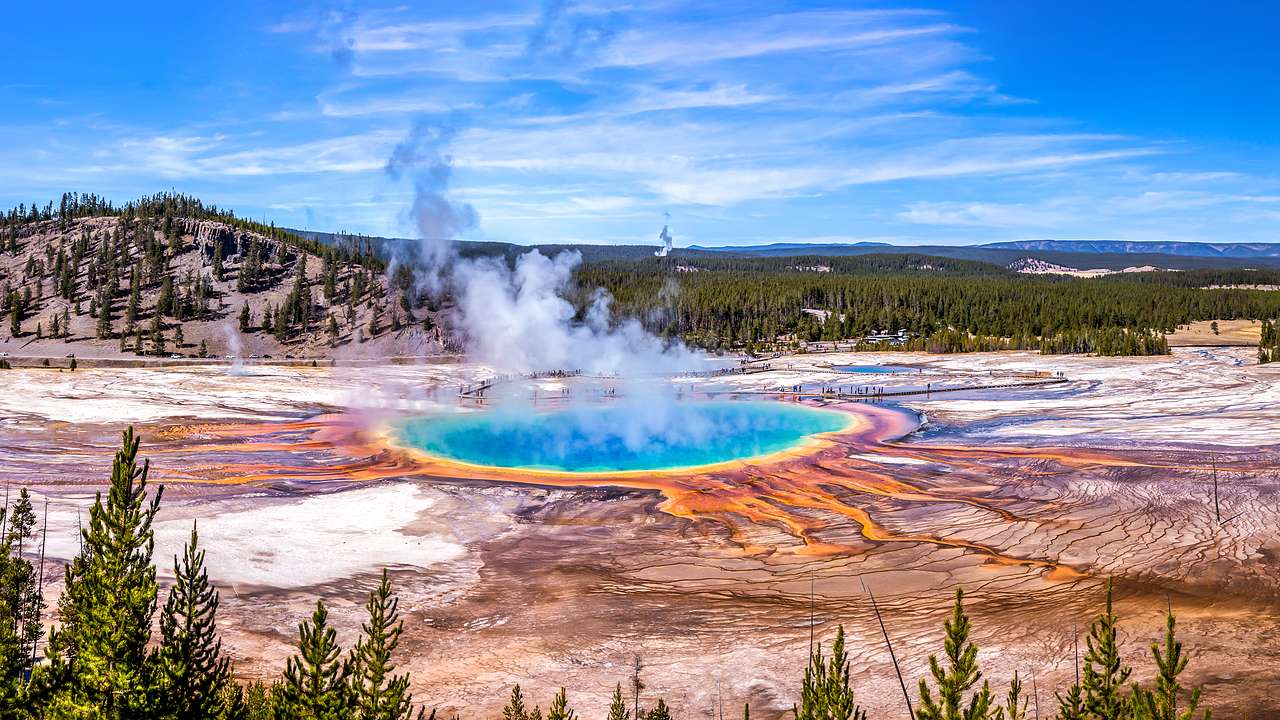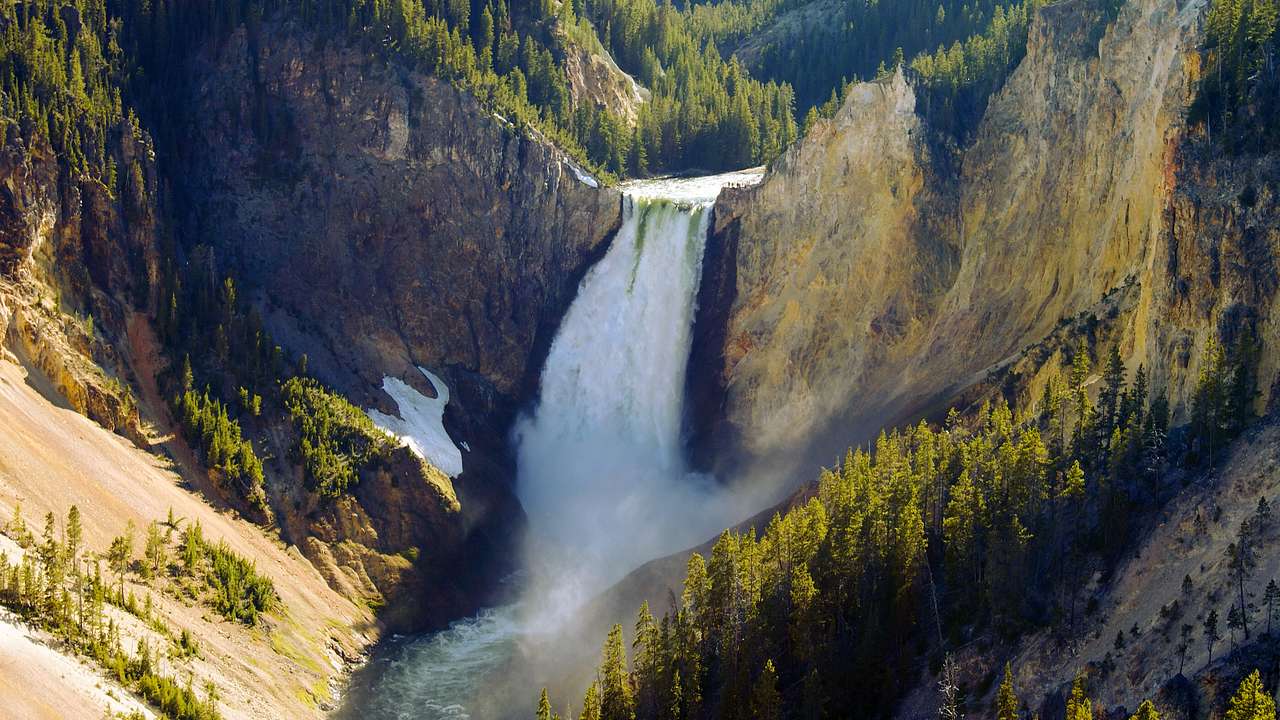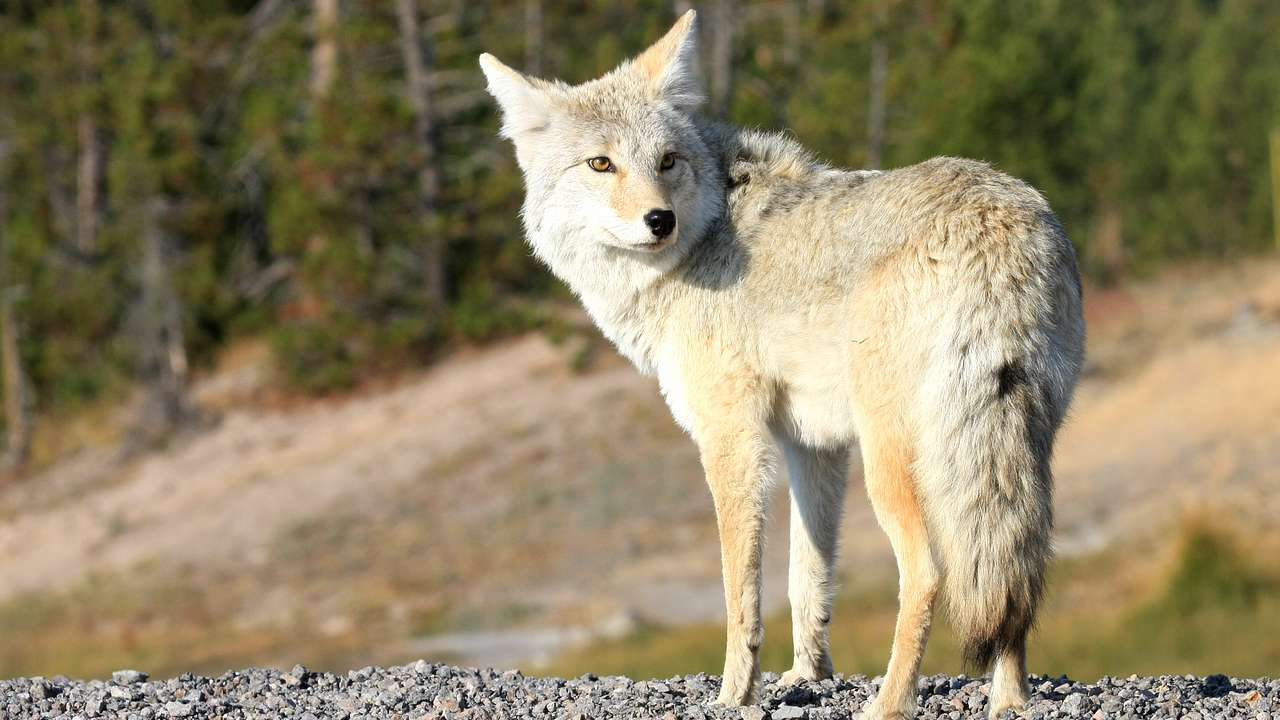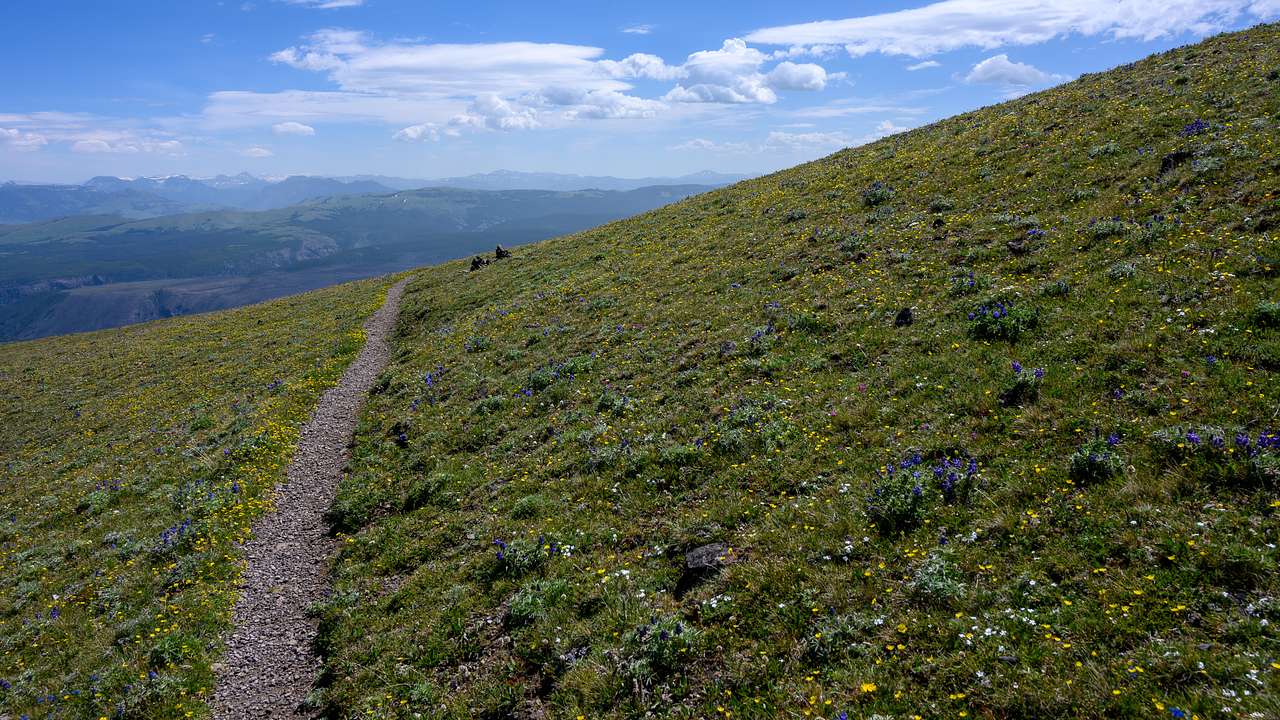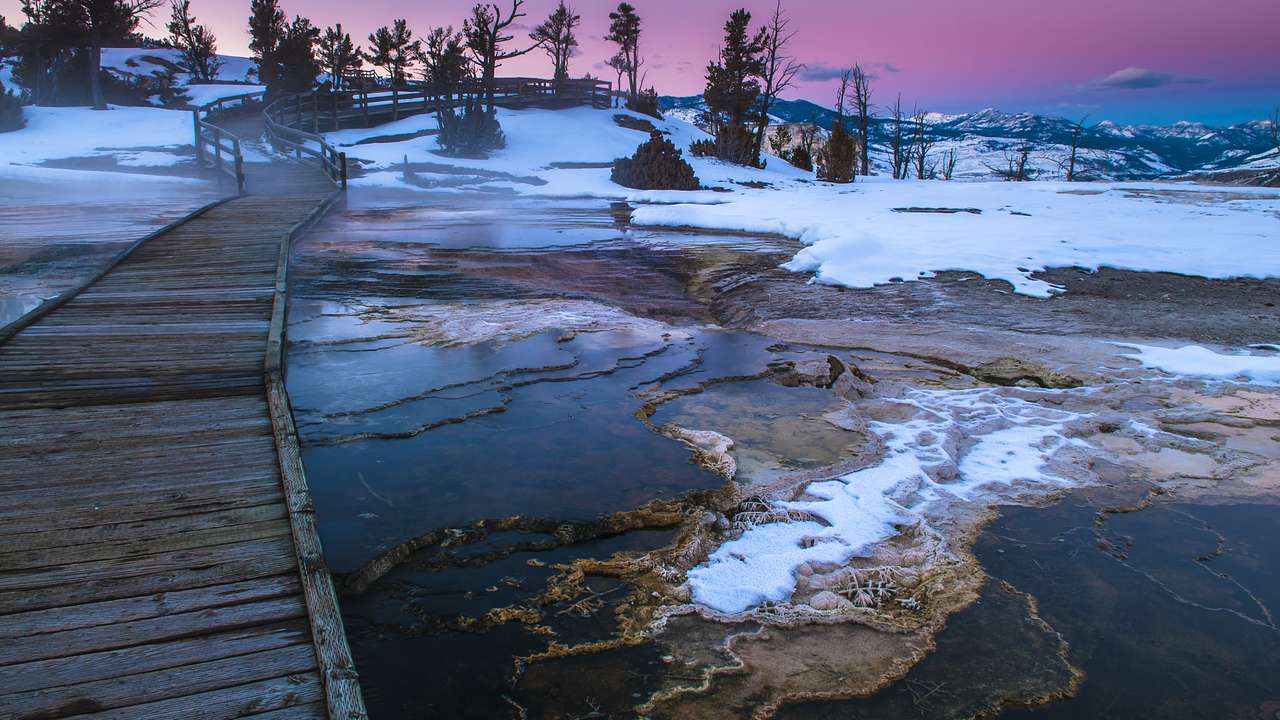Best Time to Visit Yellowstone National Park
Destguides may receive commissions from purchases made through affiliate links in this article.

Yellowstone was established in 1872 as the world's first National Park. Rich in geological features, stunning views, and an abundance of wildlife, Yellowstone National Park is a must-see!
Yellowstone National Park spans almost 3,500 square miles of unspoiled wilderness throughout Northwest Wyoming. Parts of the park also spill over onto the borders of Montana and Idaho. Yellowstone is home to hundreds of animal species, most famously including grizzly bears, bison, and wolves.
The landscapes of Yellowstone National Park are diverse and include mountains, waterfalls, and geothermal "hot spots." The park's location atop a supervolcano feeds some of its most famous geothermal features. The kaleidoscope of colors found in Grand Prismatic Spring and the erupting geyser known as Old Faithful showcase some of this incredible geothermal power.
Over four million people visit Yellowstone every year, making it one of the most famous landmarks in Wyoming. Every season offers a different experience, from weather elements to types of wildlife. Read on to learn when is the best time to visit Yellowstone National Park for you!
Organizing a last-minute visit to Yellowstone National Park?
To make the most of your visit to Yellowstone National Park, we recommend you book accommodations and experiences soon. See the short list of top suggestions below.
🏨 Top accommodations in Yellowstone National Park
- Explorer Cabins at Yellowstone (rated highly)
- The Virginian Lodge (relax by the pool)
- Fireside Resort (4-star rating)
☂️ Top tours and experiences in Yellowstone National Park
- Full-Day Private Tour in Yellowstone National Park (likely to sell out)
- Lake Yellowstone Half Day Kayak Tours Past Geothermal Features (rated highly)
- Full-Day Guided Yellowstone Day Tour (rated highly)
- Grand Canyon of the Yellowstone Rim & Loop Hike With Lunch
- Lamar Valley Safari Hiking Tour With Lunch
Visiting Yellowstone National Park Travel Tips
-
Planning a Trip to Yellowstone
- When is the best time to go to Yellowstone National Park?
- Which is the best season to visit Yellowstone National Park?
- When is the best time to visit Yellowstone National Park for wildlife?
- When is the best time to visit Yellowstone National Park for hiking?
- When is the best time to visit Yellowstone National Park for camping?
- When is peak season in Yellowstone National Park?
- When is the low season in Yellowstone National Park?
-
Weather, Prices, and Crowds in Yellowstone National Park
- Yellowstone National Park in January
- Yellowstone National Park in February
- Yellowstone National Park in March
- Yellowstone National Park in April
- Yellowstone National Park in May
- Yellowstone National Park in June
- Yellowstone National Park in July
- Yellowstone National Park in August
- Yellowstone National Park in September
- Yellowstone National Park in October
- Yellowstone National Park in November
- Yellowstone National Park in December
Yellowstone National Park Best Time to Visit Tips Video
Check out our highlights video of Yellowstone National Park best time to visit tips.
Planning a Trip to Yellowstone

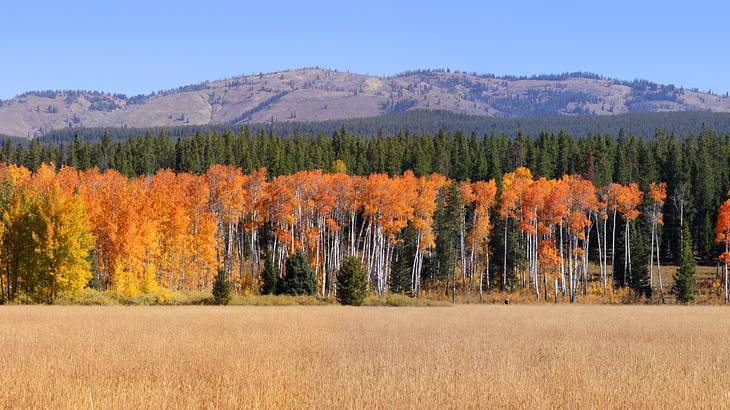
When is the best time to go to Yellowstone National Park?
Yellowstone is one of the most visited National Parks in the United States. Therefore, the off-season months of April, September, and October are regarded as the best months to visit Yellowstone. These months will often have fewer crowds, mild weather, and still plenty of wildlife to see.
Deciding on when to visit Yellowstone will also depend on the goals of your trip. Are you hoping to catch a glimpse of a mama bear with some cubs? That would be more likely in the spring (March, April, and May). Or, do you want to go snowshoeing and wolf-watching? In that case, winter is your time (December, January, and February).
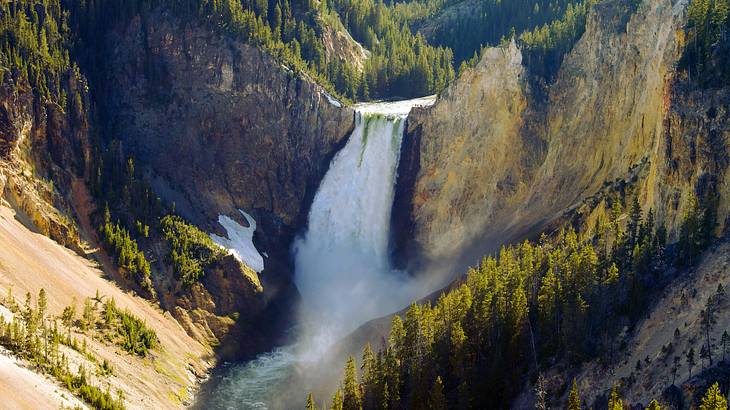
Which is the best season to visit Yellowstone National Park?
Every season offers visitors a vastly different experience. The best season for Yellowstone will be the one with the activities or experiences you are most interested in. Keep this in mind as you build your perfect Yellowstone itinerary.
Spring in Yellowstone National Park (March, April, and May) is best for hiking and wildlife watching. The weather can still be a little chilly with daytime temperatures typically ranging from the 30 to 60 degrees Fahrenheit but the wildlife is very active. Meadows throughout the park often have bears, wolves, elk, and bison.
Summer in Yellowstone National Park (June, July, and August) is the most crowded. Hiking, backpacking, and camping are most popular during the summer. Wildlife spotting is still good but bears are less visible in the summer as they move to higher elevations during warmer weather. Summer temperatures at Yellowstone can range from 60 to 80 degrees Fahrenheit.
Fall or Autumn in Yellowstone National Park (September, October, and November) offers cooler temperatures and opportunities to see bears again as they come down to feed in preparation for their winter hibernation. Hiking is still very popular in the fall and lower elevation areas may have colorful foliage. Fall temperatures in Yellowstone can range from 10s to 60s degrees Fahrenheit.
Winter in Yellowstone National Park (December, January, and February) is one of the most restrictive times with icy roads and many no-go areas. Temperatures range from below 0 to 20 degrees Fahrenheit. Bears will be in their dens for the winter and are rarely ever spotted but wolves are most active. Skiing and snowshoeing activities are very popular activities during the winter.
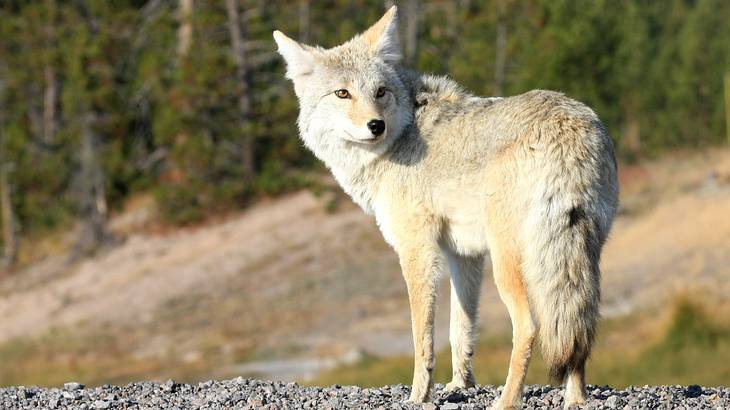
When is the best time to visit Yellowstone National Park for wildlife?
The best time to go to Yellowstone for wildlife is typically in the spring (March, April, and May). Bears emerge from their dens in early spring and are often spotted in meadows bordering the roads. Spring is also bison calving time and elk migration. In late spring, wolf pups begin to emerge from their dens and wildflowers will already be in bloom attracting all sorts of small mammals and birds
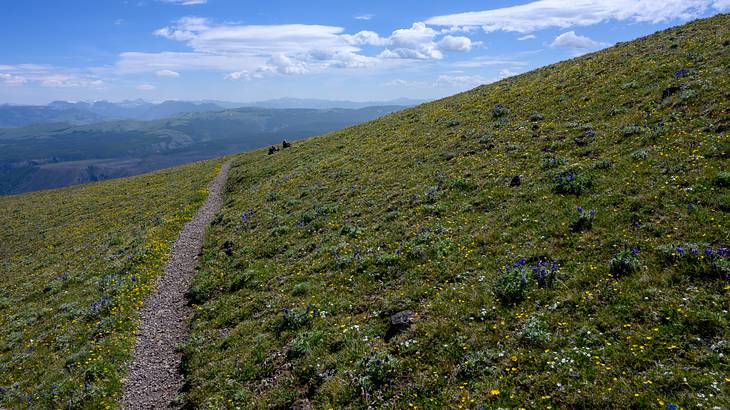
When is the best time to visit Yellowstone National Park for hiking?
The best time of year to visit Yellowstone for hiking is April through October. The weather is usually mild and, barring unrelated issues, most trails are open. Wildlife spotting opportunities are high.
The summer months (June, July, and August) in particular are the park's busiest so be prepared to share the trails. To avoid the crowds stick to April, May, September, or October.
Hiking trails at higher elevations in Yellowstone can retain snow through June. It is recommended to check on the current conditions at the visitor center or ranger station.
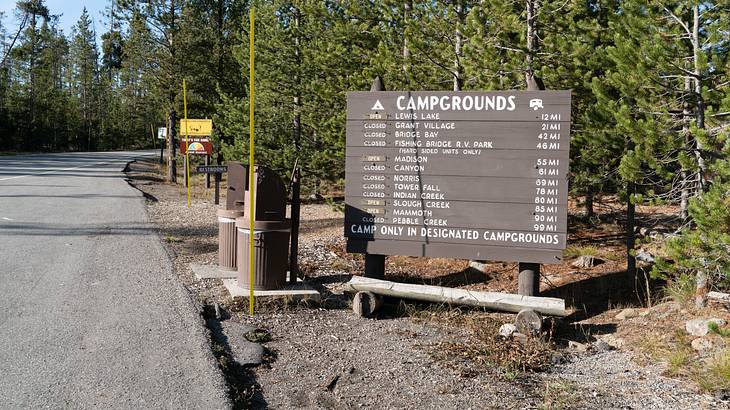
When is the best time to visit Yellowstone National Park for camping?
Most campgrounds in Yellowstone National Park are only open from April through October and are usually booked far in advance. Summer (June, July, and August) is often seen as the best time to go camping in Yellowstone, but it is also the most crowded, and a campsite is much harder to reserve.
To increase your odds of booking a campsite and having fewer crowds to contend with, the best time to travel to Yellowstone is probably April, May, September, or October. Back-country camping at Yellowstone is an option but requires a permit and much more preparation than for traditional camping.
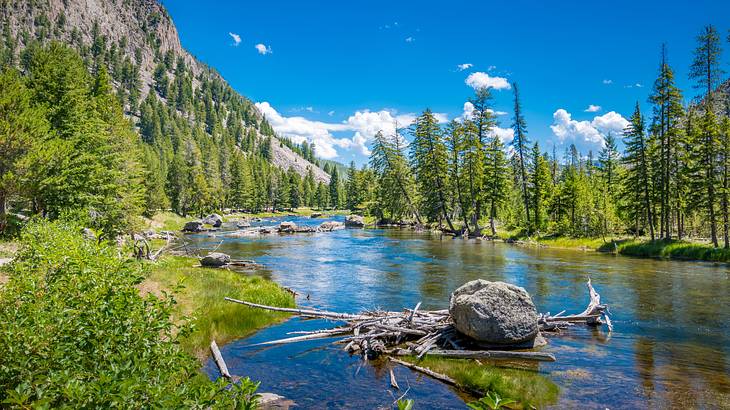
When is peak season in Yellowstone National Park?
Summer (June, July, and August) in Yellowstone National Park is the busiest time with family vacations at an all-time high. It can also be the hottest with temperatures reaching into the 80s (degrees Fahrenheit) making it a prime time for water recreation activities. The many lakes in Yellowstone can be just as crowded as the trails are in the summer.
Finding lodging at Yellowstone in the summer can be challenging and more expensive. If you are traveling from out of state, flights to major airports around Yellowstone are typically priced higher during the summer months. Overall, summer is at a premium for prices and crowds.
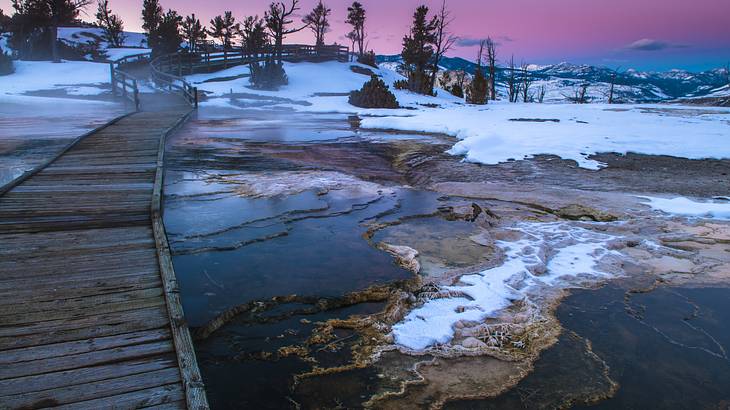
When is the low season in Yellowstone National Park?
Winter (December, January, and February) is the low season at Yellowstone National Park. With temperatures ranging from below 0 to 30 degrees Fahrenheit and roads covered in snow, movement within the park is restricted to skiing, snowmobiling, and snowshoeing.
And, of course, there is the snowcoach for those willing to forgo some of the attractions. Winter can still be a wonderful time to visit despite the mobility shortcomings. Crowds are at their lowest and prices for lodging and flights to Yellowstone tend to be much lower.
Weather, Prices, and Crowds in Yellowstone National Park

Yellowstone National Park in January
January in Yellowstone National Park is a winter wonderland with snow-covered trees, frozen lakes, and icy waterfalls–but it does have its downside. Temperatures can range from 4 to 25 degrees Fahrenheit. Many of the roads are closed, and some of the park's most famous attractions like the "Old Faithful" geyser are inaccessible at times.
Lodging is limited in January with only two facilities that stay open during the winter–Old Faithful Snow Lodge and Mammoth Hot Springs Hotel. Prices can fluctuate based on availability but are still typically lower than the high season, making winter a budget-friendly time to visit Yellowstone.
Guests that visit in January will have some extra perks including fewer crowds and unique activities only available in the winter. Skiing, snowshoeing, and snowmobiling are available during January. Wolves, coyotes, and foxes are the most active wildlife in Yellowstone during the winter.
Yellowstone National Park in February
Similar to January, Yellowstone in February is usually very cold and snowy. February temperatures range from 4 to 30 degrees Fahrenheit. Many roads are closed and lodging is limited. It is one of the least frequently visited times of the year so crowding is never an issue. Prices for flights and accommodation are also generally lower.
Snow activities are still the most popular in February and in some cases are the only way to get around the park in snow conditions. Except for some main roads near major park entrances, many of the park's interior roads are only accessible via snowmobile or snowcoach.
Bison, elk, and moose often congregate in the valley as they retreat from higher elevations to avoid the harshest temperatures. Wolves are still very active and are a highlight for the many visitors who come to Yellowstone during the winter.
Yellowstone National Park in March
March in Yellowstone is still quite cold at between 10 and 39 degrees Fahrenheit with many areas continuing to have snowfall and limited road access. Visitation is still low in March but it is a good time for wildlife viewing. Grizzly bears emerge from their dens and many species of wildlife congregate in the valleys to escape the cold of higher elevations.
March is a very good time to see some of the park's most magnificent wildlife while the crowds are still low. For those willing to brave the cold, hiking trails can be quite scenic with snow-frosted trees and migratory birds starting to return to the forests.
Lodging options are still minimal in March so making reservations ahead of time is recommended. Yellowstone prices for flights and accommodations in March can be a little higher than in winter but still lower than in the high season.
Yellowstone National Park in April
April in Yellowstone is one of the best times to see wildlife. Bears are out of their dens, bison calves are being born, and the bird life is very active. The wildflowers in the meadows begin to bloom in April. Grizzly bears and their cubs can often be found playing and foraging in the meadows.
The park does see higher visitation rates as more roads begin to reopen but April is still considered the low season. Temperatures can still be cold (ranging from 19 to 46 degrees Fahrenheit), especially in the mountains but most hiking trails are accessible. It's also a great time to explore the thermal areas of the park.
April is often the last chance for skiing or snowshoeing at Yellowstone until the following winter. These activities are pursued in the higher elevation areas only.
Yellowstone National Park in May
May is considered a moderately busy time at Yellowstone with all roads opening, milder weather between 28 and 53 degrees Fahrenheit), and wildlife activity in full swing. Bears continue to be very active, moving throughout the meadows during the day. Herds of bison and elk are visible traveling along the roadsides. Wolf pups also make their debut in May and can be spotted among their packs in the valley.
In May, additional lodging begins to open up at Yellowstone and it becomes easier to find accommodation before the high season hits. Pricing is considered moderate during this time except for Memorial Day towards the end of May; hotel and flight pricing is known to surge around holidays.
Yellowstone National Park in June
June is the beginning of the summer high season at Yellowstone. Visitation numbers and prices start to creep up as schools across the US go on summer break. Campgrounds and lakes around Yellowstone open up in June to kick off summer recreational activities.
June is one of the best months for great weather in Yellowstone. Temperatures are in the 60s and 70s degrees Fahrenheit during the day and are suitable for all outdoor activities. Waterfalls are usually flowing at full intensity in June.
Wildlife is still abundant in Yellowstone in June but bears specifically become less visible as they move into higher elevations during this time. Visitors who stay overnight in the park can be treated to some excellent stargazing opportunities.
Yellowstone National Park in July
Yellowstone in July is one of the busiest months–especially around the Independence Day holiday. Visitors to Yellowstone in July can expect high traffic, large crowds, and long lines for services. Plane tickets to airports near Yellowstone are also notoriously high in July.
Water recreation activities in Yellowstone often peak in July as the weather gets hotter, with daytime temperatures in the 70s and 80s degrees Fahrenheit. Lakes are often incredibly busy with kayakers, swimmers, and fishermen. Reserving campsites or hotels can be much harder in July.
July in Yellowstone does have its upside. The park is virtually brimming with wildlife at every turn. Herds of bison and elk roam the greenways, small mammals and birds occupy the meadows, and otters can be seen swimming in the rivers.
Yellowstone National Park in August
August in Yellowstone is another one of the park's busiest months. It is usually one of the hottest with temperatures climbing into the 80s (degrees Fahrenheit). Water recreation and lake areas continue to be crowded throughout August.
Back-country hiking and camping are very popular in August for those who wish to get away from the more crowded areas of the park. Ranger-guided tours and horseback riding are also available. Bison and elk are the most common wildlife seen around Yellowstone in August.
Travel expenses to Yellowstone in August are still at their highest with it being peak season. Hotel accommodation and campground reservations are snapped up way before August rolls around so it's best to book as far as a season in advance.
Yellowstone National Park in September
September is one of the best months to go to Yellowstone. Crowds subside and prices come down after Labor Day as children head back to school. The weather starts to cool down to between the 50s and 60s degrees Fahrenheit) and fall foliage is visible at higher elevations. September is a great time to visit Yellowstone for hiking and camping.
Wildlife viewing opportunities in Yellowstone are also abundant in September. Bears return to the valley once again to start their fall feeding before their winter hibernation. The raptor migration commences with eagles and hawks spotted overhead. Bison and elk roam freely throughout the park as they start their mating season.
Yellowstone National Park in October
October in Yellowstone is marked by crisp fall temperatures ranging from 24 to 58 degrees Fahrenheit, increased bear activity, and the first snowfall in higher elevations. Visitation is low to moderate and costs usually reflect off-season prices. October is seen by many as the best time to visit Yellowstone to avoid crowds before the truly cold weather arrives.
While October is still great for hiking and seeing wildlife, visitors should be aware that certain areas of the park begin to close at this time. All campgrounds are closed and road access becomes limited. Some hotels and lodges also start to wind down operations for the season.
Bears are on the move throughout the park as they feed nonstop in preparation for the winter. Most of the other wildlife is also highly visible as they migrate throughout the park. October is also a great time to visit the geyser basins as the weather is still quite pleasant and crowds are lower.
Yellowstone National Park in November
November in Yellowstone marks the beginning of the true low season. As temperatures drop dramatically to between 13 and 34 degrees Fahrenheit so does human visitation to the park. Snow starts to fall in the park's lower elevations and the bears go into hibernation.
More roads close to vehicles as snow piles up and park services become limited. Only two lodges remain open during winter. While pricing can fluctuate, visitors can generally expect rates to be 20%-40% lower than in the high season.
November still has good wildlife viewing opportunities with large herds of bison moving into the lower elevations. It is also the beginning of the most active time for wolves.
Yellowstone National Park in December
December is one of the coldest months in Yellowstone with temperatures ranging from 0 to 26 degrees Fahrenheit but it is popular for snow activities. Many roads are impassable making snowmobiles and snowcoaches the only methods of transportation. Ranger-guided snowshoe tours are favorites.
Except during the week of Christmas, Yellowstone pricing is much lower in December. Some lodging options offer their lowest rates during the winter as visitation to the park is historically low.
Wildlife viewing is still possible in the valley in December with wolves being one of the most iconic species. Wolf-watching is a favorite pastime among Yellowstone visitors in winter as these majestic creatures are at their most active. Herds of snow-covered bison are not an unfamiliar sight.
In Summary
With so many things to see and do it's easy to see why Yellowstone National Park is one of the most famous landmarks in America. It also tops the list of best things to do in Wyoming and has the most famous landmarks in Montana.
Whether you want to see geothermal pools, climb a peak, or ride snowmobiles through frosty forests, there's a right time to visit Yellowstone for that.
Of course, no trip to Yellowstone would be complete without seeing some of the park's incredible wildlife. From bears to bison, Yellowstone's wildlife is a national treasure!
Give us feedback about this article
More visual stories related to this article:
Want to keep exploring?
Subscribe for discounts on tickets and hotels and our latest guides.
Thank you for subscribing
We will be in touch soon with discounts on tickets and hotels and our latest guides.
Want to keep exploring?
Subscribe for discounts on tickets and hotels and our latest guides.
Thank you for subscribing
We will be in touch soon with discounts on tickets and hotels and our latest guides.

